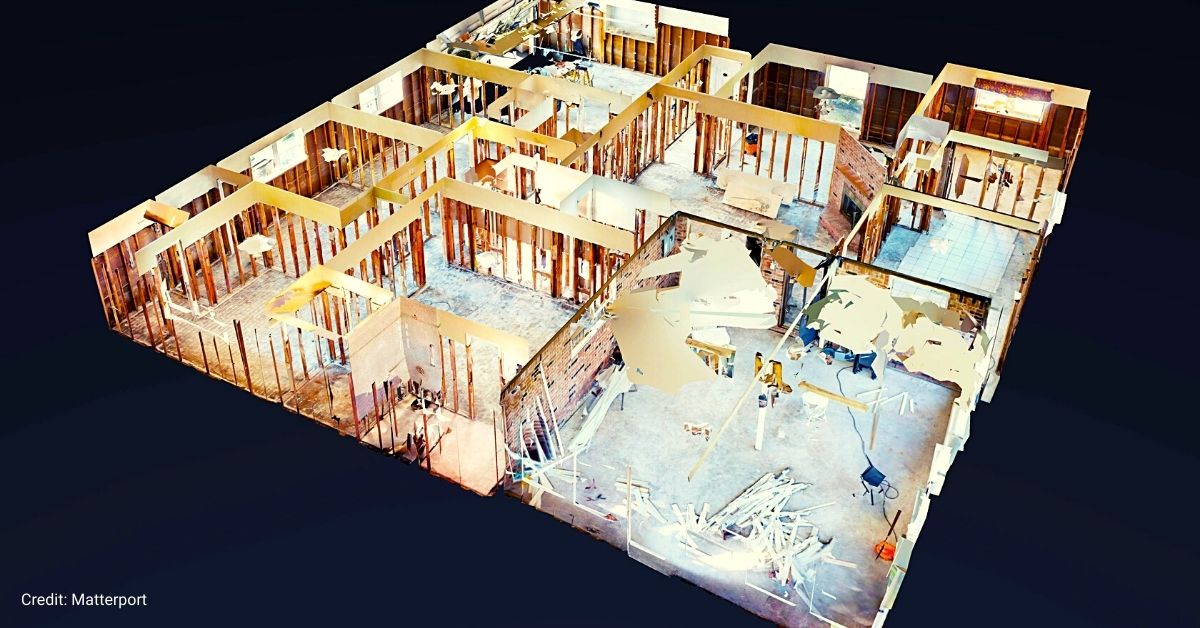By Cameron Black | November 30, 2021
When it comes to assessing interior damage and generating repair estimates, digital technology can be leveraged to increase speed, accuracy, and reliability. In fact, 90% of small businesses say digital tech tools have helped foster innovation in their business.1
At RMC Group, we may leverage 3D digital tool Matterport in one of your upcoming assessments.
A 3D imaging platform designed to collect and analyze spatial data, Matterport looks much like a camera sitting on a tripod. Now, imagine that camera has a laser scanner, and when you spin the tripod 360 degrees, it can capture an image of the entire space as well as hundreds of other unique measurements — with accuracy down to 1/16th of an inch.
3D imaging tools like Matterport are gradually becoming industry standard for restoration, reconstruction, and repairs – and rightfully so. With COVID and adjusters being unable to physically get on site, 3D tools like Matterport allow adjusters to virtually walk the site to get a good idea of the damage and or required repairs. For this reason and more, there’s been a huge rise in utilization of 3D imaging in the restoration space.
5 Ways 3D Imaging Can Enhance Repair Estimates

There are many reasons to engage 3D imaging in repair estimates. Here are our top five:
1. Accuracy – No matter how efficient humans are, mistakes are par for the course. 3D imaging is comparatively far less prone to error, producing entirely accurate spatial measurements in 99% of cases. The 3D imagery produced by Matterport’s camera also boasts significantly higher resolution, catching every bump and bruise that needs to be accounted for down to the finest detail. With only a camera, an estimator would have to take 10 shots to capture a single area. Accurate pictures make for precise measurements, and in therefore, precise estimating.
2. Speed – Between taking hundreds of pictures and careful measurements, manual inspections are incredibly costly and time consuming. With 3D technology, the estimator takes both pictures and measurements at the same time — cutting their measurement time in half. This makes estimates more efficient, whether in the context of a small commercial office suite or a 10-story hotel.
3. Witness – For legal purposes, Matterport produces a reliably accurate and accessible record of damages in the form of a 3D image. If a dispute arises related to damages, the area in question can be viewed in high resolution at whatever angle is necessary, eliminating the need to shuffle through a stack of grainy individual images to make an appropriate determination. 3D imaging also creates unique value by serving as an intuitive map that clients can easily access and review as if they were right there in the room.
4. Connectivity – Matterport can integrate with multiple tech tools, including building information modeling (BIM) for construction design and overlay imaging with Xactimate. The interactive images and measurements taken by Matterport can be accessed exclusively by project team members with a simple, sharable link. This is a great tool for walking through the imagery related to the assessment even when you are not onsite.
5. Illumination – Darkness can be a serious problem when performing a manual inspection. Whether you’re trying to get a clear picture of a closet or basement, or attempting to capture images during a power outage, doing so with a camera in one hand and a flashlight in another is an impractical approach. Instead of trying to juggle multiple pieces of equipment all while balancing a camera, the addition of a professional lighting mount on the Matterport helps estimators take steady measurements and pictures with the same accuracy in the dark as they would in a well-lit room.
Existing Challenges and Barriers to Using 3D Imaging
In addition to its myriad benefits, 3D imaging also has some limitations that shouldn’t be overlooked. Here are a few existing challenges and barriers to using 3D imaging for repair estimates.
Training Requirements – Although 3D cameras and their components are easy to use for those who are familiar with the technology, those who are less tech-savvy will come up against a considerable learning curve. Adequate instruction on how to upload Matterport imaging, how to share and how to download will ultimately be critical to using the technology effectively, and some senior estimators will naturally be reluctant to invest the time and resources needed for proper training.
Buy-In – 3D imaging is a hard sell for more senior estimators, who tend to be more hesitant when it comes to most tech integrations.
Cost – Matterport cameras are expensive initially. Upfront costs can range from $2200 to $3500 with multiple accessories and the software data storage may add an additional charge per month. Those looking to save on the camera can opt to use the Matterport app on a handheld device, but they will ultimately end up with an inferior product in terms of accuracy. The assumption here is that the ROI is greater than the initial investment due to the savings derived by the efficiency, speed, and accuracy of the camera.
Contact RMC group for more information on 3D imaging and repair estimates.
Source:
1 Deloitte. The performance of small and medium sized businesses in a digital world. 2019
